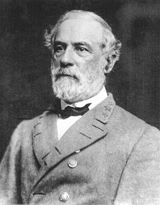Robert Edward Lee
 Robert Edward Lee was born on January 19, 1807, at "Stratford" in Westmoreland County, Virginia. He was the fifth child born to Henry "Light-Horse Harry" Lee and his second wife, Ann Hill (Carter) Lee. He grew up in an area where George Washington was still a living memory. Robert had many ties to Revolutionary War heroes.
Robert Edward Lee was born on January 19, 1807, at "Stratford" in Westmoreland County, Virginia. He was the fifth child born to Henry "Light-Horse Harry" Lee and his second wife, Ann Hill (Carter) Lee. He grew up in an area where George Washington was still a living memory. Robert had many ties to Revolutionary War heroes.Content Provided By:

|
Robert E. Lee |
Robert E. Lee
1807-1870, Virginia
Lee, a member of a prominent Virginia family, was the son of "Light Horse Harry" Lee, a hero of the American Revolution. His older brother, Sydney Lee, served as commandant at Annapolis, commanded Commodore Perry's flagship in the Japan expedition, and later served in the Confederate Navy. Robert graduated from West Point in 1829, second in his class of forty-six. He then served at various forts along the east coast before being assigned chief engineer for the St. Louis, Missouri, harbor. During the Mexican War Lee served on the staff of General Winfield Scott in the Vera Cruz expedition, receiving in succession the brevets of major, lieutenant colonel, and colonel. After the war Lee returned to supervise construction of fortifications until appointed superintendent of West Point, a position he held from 1852 to 1855. Later he was transferred from the engineer corps and assigned as lieutenant colonel of the 2d Cavalry. In late 1859 the abolitionist John Brown made his raid on the U.S. arsenal at Harper's Ferry; Lee, on leave in Washington, was sent with a force of marines from the Navy Yard to capture the raiders. In early 1861 Lee was promoted to colonel of the 1st Cavalry, his commission signed by the newly elected Abraham Lincoln. However, when he was offered command of forces that would invade the South, Lee resigned his commission.
In late April he was appointed major general and commander of Virginia military forces. A month later, when Virginia became part of the Confederacy, Lee was commissioned first a brigadier general in the Confederate Army (no higher rank having been created at that time) and later general. In March 1862 he became the military adviser to President Jefferson Davis. At the beginning of June Lee succeeded the wounded General Joseph E. Johnston in command of the Army of Northern Virginia in charge of defending Richmond. Lee led his army through a series of victories-at the Battles of the Seven Days, Second Bull Run, Fredericksburg, and Chancellorsville-punctuated by reverses at Antietam and Gettysburg. In February 1865 Lee was appointed general in chief of the Confederate armies; but two months later, on 9 April, he was forced to surrender the Army of Northern Virginia at Appomattox Court House. After the war Lee accepted the presidency of Washington College at Lexington, Virginia, and served there until his death. (The school's name was later changed to Washington and Lee University.)
Content From:
The U.S. Army Center of Military History



